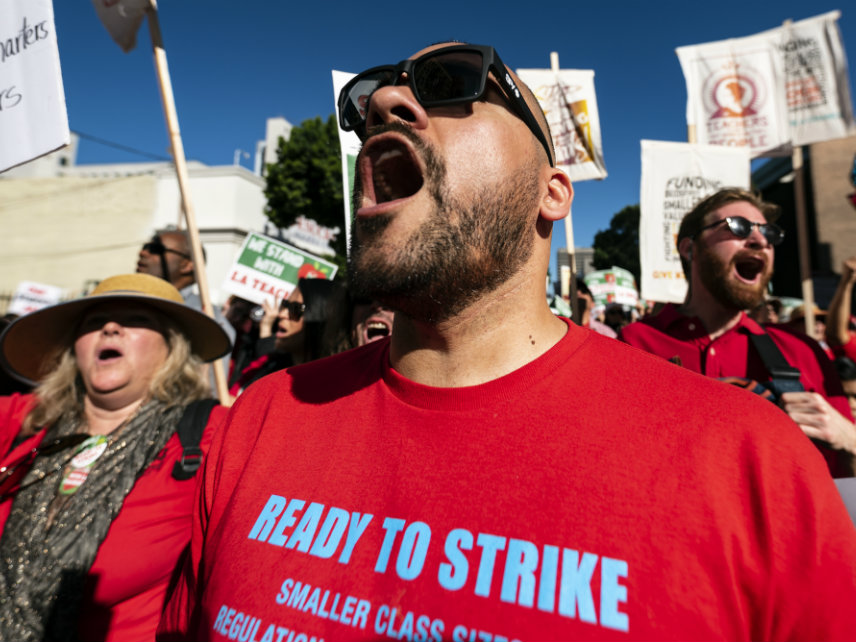L.A. Teachers to Strike After Rejecting Offered Pay Raise
They were offered 3 percent, but wanted 6.5. The district probably can't afford that.

After a temporary delay, teachers in the Los Angeles Unified School District seem likely to go on strike Monday morning. They are demanding, among other things, a 6.5 percent pay increase after rejecting a 3 percent hike offered by the district.
About 30,000 teachers in the nation's largest school district had originally planned to strike on January 10, but union leaders postponed the strike until Monday after a judge ruled that the union had failed to give the district adequate notice for the work stoppage. Even with a few extra days to reach an agreement, the two sides remain apart, according to the Los Angeles Times, despite the district offering to pay an additional $75 million to meet union demands regarding staffing levels and class sizes.
The main disagreement, of course, is about wages. The union wants a 6.5 percent raise immediately, while the district has offered a 3 percent raise followed by another 3 percent raise next year, the Times reports. (Update: The average LAUSD employee earns $73,000 annually.)
Even without handing out pay raises, the Los Angeles Unified School District finds itself in dire financial straits.
On its current trajectory, the school district will face a $422 million shortfall by 2020, driven in large part by its $15 billion in unfunded health care benefit liabilities for current workers and retirees. A task force that studied the district's fiscal condition in 2018 concluded that the structural deficit "threatens its long-term viability and its ability to deliver basic education programs."
A major driver of the budget problems at the LAUSD is employee pension and health care costs. According to the budget task force, those costs will consume more than half of the district's annual budget by the end of the next decade. Since there is no way to give employees raises without also increasing the future liabilities owed by the pension system, boosting pay now will only add to the long-term problems facing the district.
"LAUSD has already offered much more than it can afford (increase teacher pay across the board, dollars for lower class sizes, and new positions) so either way the resolution will likely expedite the drawdown of the district's reserves," says Aaron Smith, an education policy analyst for the Reason Foundation, which publishes this blog.
The other major issue is class sizes. The union is demanding that the district hire more teachers and staff to reduce the average class size in Los Angeles schools—which currently range from an average of about 26 students per class in elementary schools to nearly 40 per class in the city's high schools. In its most recent offer, the school district said it would set caps of 37 students for high school classes and 34 students for lower grades.
But while smaller class sizes would be nice, that's far from the only consideration facing the LAUSD. As even former Obama-era Education Secretary Arne Duncan has argued, teacher quality matters far more than class size as a determinant of student outcomes.
Hiring more employees is unlikely to solve the district's problems. Since 2004, the LAUSD has seen a 16 percent jump in administrative staffers while student enrollment has fallen by 10 percent. Increasingly, students (and their parents) are opting for charter schools, which have proven to be successful and efficient alternatives. More than 160,000 students already attend charter schools in Los Angeles, and another 41,000 are on waiting lists trying to get in.
The school district likes to blame its structural problems on the loss of students to charter schools—but the real problem is that LAUSD has failed to adapt to changing circumstances. In 2015, the district's Independent Financial Review Panel made a series of recommendations to help the district adjust to competition from charters—for example, if employees and retirees had to cover just 10 percent of their health insurance premiums, the district could save $54 million annually. Those ideas have mostly been ignored.
A long strike will likely only exacerbate those problems, warns Smith. A protracted strike may encourage more families to seek out alternatives to the public schools.
"If anything," he says, "the strike will further illustrate exactly why more (not fewer) charters are needed."


Show Comments (96)